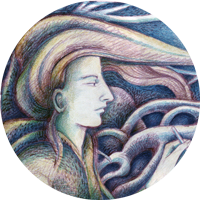
It was so good to get away. I’d been in Brighton a bit too long and unable to break free of it because of the lockdown restrictions on travel. Last week we drove to Dorset and spent three nights in a lovely, spacious artist’s studio in an area of rolling hills, earthworks and rookeries. The birdsong was amazing. Two chilly mornings I stumbled out of my dreams at 5.40am on to the frosted grass of the garden to record the dawn chorus:
Listen to the dawn chorus in Pentridge:
Chaffinches, blackbirds, robins, a pheasant, rooks – we were beneath a rookery. I’ve wondered what it must be like to sleep beneath a rookery ever since I read about Roger Deakin sleeping out in Wildwood. Rooks do quieten down at night.
We watched the moon waxing, becoming bolder in its silence with each passing night as it loomed towards full; a pink supermoon, a blossoming planet. Now it’s time has passed and it’s waning once again.
One morning I set off alone up Pentridge Hill above the village. ‘Pentridge’ means Hill of the Wild Boar; from pen for hill and twrch for boar in the old Celtic language of Britain.

The wind had a distinct chill that made my eyes stream. Far off in the pines ahead of me I heard a cuckoo. It seemed to beckon, so I followed. I followed it to the western edge of the copse of trees, through gorse and bracken. I scanned the tree branches all around. Cuckoo, cuckoo now came from a tree along the southern edge. I followed the call up, along, over and through, weak sunshine sending out long, shape-shifting shadows.

It was close by but I couldn’t see it. With the wind blowing and the light wavering through the branches, the call of the cuckoo now haunted me from the east. When I walked to the east of the hill it sounded from another copse of trees, far away. The elusive bird!
They say the call of the cuskoo means spring is on its way. For some, hearing the cuckoo for the first time in the year is a sign of increasing wealth, especially if you turn some coins in your pocket. ( I didn’t have any coins in my pocket, only a mangled feather.) For others it is a more omenous sign of impending storms, hunger or death. Apparently the 28th April is known as ‘cuckoo day’ in Cornwall. There seem to be plenty of other ‘cuckoo days’ too.

Pentridge Hill was the site of ancient Mesolithic and Neolithic settlements. There is so much evidence of ancient people in the whole area of Cranborne Chase – long barrows, tumuli, a cursus, Roman roads and dykes. We had some fascinating conversations with the studio owner, who told us about the local archaeology and archaeologists in the area. While out walking she said she’d found a Neolithic flint axe head. Treasure indeed!
The studio and garden are full of artistic touches – life drawings, paintings and sculpted heads. The owner kindly gave me a roe buck skull to add to my collection and for me to draw. I made a few other natural finds.
We went for walks in Garston Wood, a RSPB nature reserve known for its marsh tits and spotted flycatchers. We heard coal tits calling, sounding like squeesy bottles. We then walked on to Chase Wood.
The next day we visited nearby Martin Down Nature Reserve with its strange humps and scrubby down, its skylarks and wheatears with their flashing white rumps. It felt ancient, but I couldn’t really put my finger on why. Perhaps it was its old, worn, threadbare carpet look. We walked a little way along Bokerly Dyke and tried to locate Grim’s Ditch, a prehistoric earthwork, but only found an area of grass a slightly different shade of green to indicate where it could have been.
I’m now thinking about the land above and below, its folds and seams, its hidden treasures, its deep past, its future, it’s bones.







